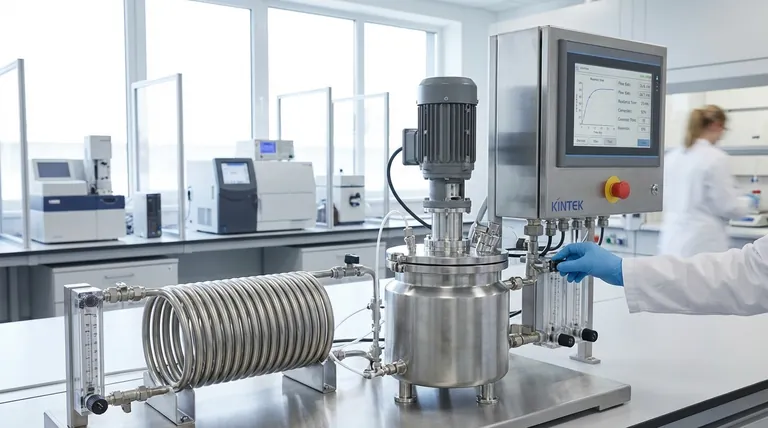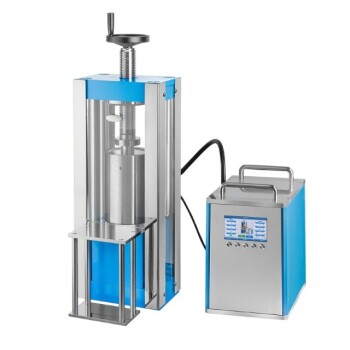In short, increasing residence time does not change the intrinsic reaction rate, but it almost always increases the final reactant conversion. The reaction rate is a measure of speed (moles/volume/time) determined by chemistry and conditions like temperature, while residence time is the average duration a molecule spends in the reactor. Giving the reaction more time to proceed naturally allows more of the reactants to be converted into products.
The critical distinction is that residence time is a process control parameter, not a fundamental property of the reaction itself. You control residence time to manipulate the extent of the reaction (conversion), but the reaction's intrinsic speed (rate) is governed by the rate law.

What Are Residence Time and Reaction Rate?
To understand their relationship, we must first define each term with precision. They are distinct concepts that operators and engineers often manipulate in tandem.
Residence Time (τ)
Residence time is the average amount of time that a particle of fluid spends inside a continuous reactor. It is a simple but powerful operational metric.
It is calculated by dividing the reactor's volume (V) by the volumetric flow rate (Q) of the fluid passing through it.
τ = V / Q
A larger reactor or a slower flow rate will result in a longer residence time.
Reaction Rate (r)
Reaction rate is the speed at which a chemical reaction occurs. It quantifies how quickly reactants are consumed or products are formed.
This rate is fundamentally determined by the chemical kinetics, expressed through a rate law. The rate typically depends on reactant concentrations and the rate constant (k), which is highly sensitive to temperature. It is independent of the reactor size or flow rate.
The Core Relationship: Time Enables Conversion
The most common source of confusion is mistaking the outcome (conversion) for the speed (rate). Increasing residence time simply allows the reaction to run for a longer duration for the average molecule.
An Analogy: Baking a Cake
Think of the reaction rate as the temperature of your oven. A hotter oven (a faster intrinsic rate) cooks the cake batter more quickly.
The residence time is the amount of time you leave the cake in the oven. Leaving it in longer doesn't make the oven hotter, but it does result in a more "converted" batter—from liquid to solid cake.
If you pull the cake out too early (short residence time), it will be undercooked (low conversion), even in a hot oven. If you leave it in too long (long residence time), you might start to burn it (unwanted side reactions).
The Impact on Conversion
For most standard reactions, increasing the residence time allows for a higher percentage of reactants to be converted into products. The reaction proceeds along its natural course for a longer period, pushing the final concentration of reactants lower and the concentration of products higher.
How Reactor Type Changes the Equation
The ideal relationship between residence time and conversion is complicated by the fact that not all molecules experience the same residence time. This is described by the Residence Time Distribution (RTD).
Plug Flow Reactor (PFR)
In an ideal PFR (like a long tube), fluid particles flow in an orderly fashion without mixing in the direction of flow. Every particle entering the reactor spends the exact same amount of time inside.
This makes PFRs highly efficient. For a given residence time, a PFR will achieve a higher conversion than a CSTR for most reaction orders greater than zero.
Continuous Stirred-Tank Reactor (CSTR)
In an ideal CSTR, the contents are perfectly mixed. This means the concentration and temperature are uniform everywhere inside the reactor, and the outlet stream has the same composition as the fluid within the tank.
Because of this perfect mixing, a CSTR has a wide distribution of residence times. Some fluid particles exit almost immediately, while others may remain for a very long time. The reaction proceeds at the lowest reactant concentration (the exit concentration), making it inherently less efficient per unit volume than a PFR.
To achieve the same conversion as a PFR, a CSTR requires a significantly longer average residence time (meaning a much larger reactor for the same throughput).
Understanding the Trade-offs
Simply maximizing residence time is rarely the optimal strategy. There are critical engineering and economic trade-offs to consider.
Diminishing Returns
As reactant concentration decreases, the reaction rate typically slows down. This means that achieving the final few percentage points of conversion (e.g., going from 95% to 99%) can require a disproportionately large increase in residence time.
Economic Costs
A longer residence time is achieved by either decreasing the flow rate (reducing throughput) or increasing the reactor volume (increasing capital cost). Both decisions have major financial implications that must be balanced against the value of increased conversion.
Unwanted Side Reactions
For many complex chemical processes, multiple reactions can occur simultaneously. A longer residence time that benefits your desired reaction may also provide enough time for slower, unwanted side reactions to proceed.
This can lead to the formation of impurities or the degradation of your desired product, ultimately reducing process selectivity and yield. Optimizing residence time is often about finding the "sweet spot" that maximizes desired product formation while minimizing byproducts.
Making the Right Choice for Your Goal
The optimal residence time is always a function of your primary objective.
- If your primary focus is maximizing conversion: Use a longer residence time, and strongly consider a PFR design or multiple CSTRs in series to approximate PFR behavior.
- If your primary focus is maximizing throughput: Use a shorter residence time and a smaller reactor, accepting a lower conversion per pass. This is common when unreacted material can be easily separated and recycled.
- If your primary focus is maximizing selectivity: You must carefully optimize residence time to favor the desired reaction pathway over side reactions, which may mean choosing a residence time that does not maximize conversion.
- If your primary focus is minimizing cost: You must perform an economic analysis that balances the capital cost of the reactor (volume) against the operational value of conversion and throughput.
Ultimately, mastering residence time is about understanding it as a powerful lever to control the final outcome of a chemical process.
Summary Table:
| Goal | Recommended Action | Key Consideration |
|---|---|---|
| Maximize Conversion | Use longer residence time; prefer PFR or CSTRs in series. | Diminishing returns at high conversion; may increase costs. |
| Maximize Throughput | Use shorter residence time; accept lower conversion per pass. | Effective if unreacted material can be recycled. |
| Maximize Selectivity | Carefully optimize residence time to favor desired reaction. | Avoids unwanted side reactions that can reduce yield. |
| Minimize Cost | Balance reactor capital cost against value of conversion. | Requires detailed economic analysis of the entire process. |
Ready to optimize your chemical processes with precision equipment?
At KINTEK, we specialize in providing high-quality lab reactors and process equipment that give you precise control over critical parameters like residence time. Whether you're scaling up a reaction in a PFR or running continuous synthesis in a CSTR, our solutions help you achieve maximum conversion, throughput, and selectivity.
Contact us today to discuss how our expertise in laboratory equipment can enhance your research and development. Let's build a more efficient and productive process together.
Get in touch with our experts now!
Visual Guide

Related Products
- Customizable High Pressure Reactors for Advanced Scientific and Industrial Applications
- Mini SS High Pressure Autoclave Reactor for Laboratory Use
- Stainless High Pressure Autoclave Reactor Laboratory Pressure Reactor
- High Pressure Laboratory Autoclave Reactor for Hydrothermal Synthesis
- Manual High Temperature Heated Hydraulic Press Machine with Heated Plates for Lab
People Also Ask
- How high pressure is created in a lab? Master Safe and Precise Pressure Generation
- How is high pressure generated in an autoclave? Unlock the Science of Sterilization & Synthesis
- What reactor is used for high pressure reactions? Select the Right Autoclave for Your Lab
- Does pressure affect melting and boiling? Master Phase Changes with Pressure Control
- What are the advantages of a chemical reactor? Unlock Precision, Efficiency, and Safety in Your Process



















